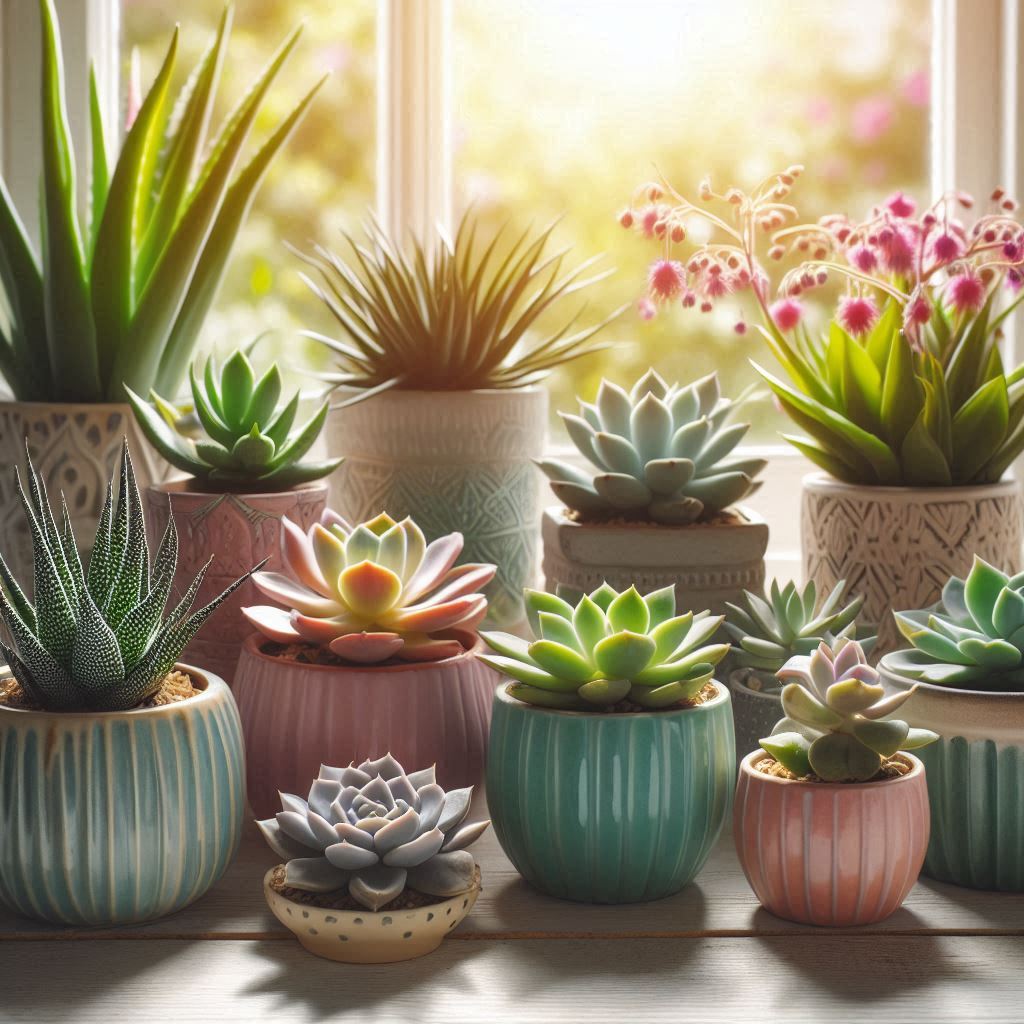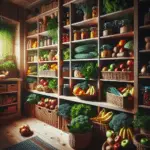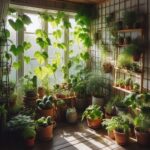1. Introduction
Succulents have become incredibly popular as low-maintenance houseplants, making them a favorite choice for both novice and experienced gardeners.
Known for their unique shapes, vibrant colors, and ability to store water in their leaves, succulents are often seen as the ideal indoor plant for those looking to add a touch of greenery to their homes without the hassle of frequent care.
Many people assume that all succulents need direct sunlight to thrive, but this is a common misconception. In fact, there are many low light succulents that grow well in darker environments, making them perfect for homes or offices with limited natural light.
One of the biggest myths surrounding succulents is that they require full sun to grow healthily. While it’s true that some succulents thrive in bright, direct light, many varieties are perfectly adapted to lower light conditions.
These low light succulent plants are well-suited for indoor environments such as bedrooms, bathrooms, or even offices with minimal sunlight. This adaptability makes them incredibly versatile and a great option for those without access to bright, sunny windows.
The benefits of low light succulents are numerous. Not only do they bring a vibrant, natural element into your home, but they also require very little attention to stay healthy. Succulents like the Snake Plant, ZZ Plant, and various low light cactus plants are particularly good choices for those who may forget to water their plants or are looking for something that doesn’t need much maintenance. Additionally, these plants can help purify the air and improve indoor air quality, making them both beautiful and functional additions to any room.
For anyone looking to add greenery to their home but lacking the bright sunlight often associated with succulents, there are plenty of options. This guide will explore some of the best indoor succulents for low light, including 27 low light succulents that grow in dark environments.
By understanding which succulents can adapt to lower light conditions, you can create a lush indoor garden that thrives, even in the dimmest corners of your home.
2. What Makes a Succulent Suitable for Low Light?
2.1. Adaptations to Thrive in Low Light
Not all succulents are created equal, and some have unique adaptations that allow them to thrive in low light conditions. Low light succulents have specific characteristics that make them resilient in darker environments, such as slower growth rates and thicker leaves that store water efficiently. These adaptations help them survive with minimal sunlight, making them ideal for indoor use.
Many of the best succulents for low light have evolved to naturally grow under the canopy of larger plants, where light is limited. For instance, succulents like Haworthia and Gasteria have developed strategies to make the most of the available light, even if it is filtered or indirect. Their ability to thrive in such conditions makes them perfect for rooms with lower light levels, such as bathrooms or offices.
2.2. Benefits of Low Light Succulents
One of the key benefits of low light succulents is their versatility. These plants can be placed in areas of your home where other plants may struggle to survive.
For example, low light succulents indoor can be used to brighten up dark hallways or corners that don’t receive much natural light. Their adaptability makes them a great choice for those looking to enhance their living spaces without worrying about the availability of sunlight.
Another benefit of low light succulent plants is their ease of care. Unlike plants that need constant attention, these succulents require minimal watering and maintenance.
This makes them ideal for individuals who may not have a lot of time to devote to plant care or who are new to indoor gardening. The best indoor succulents for low light, such as the ZZ Plant and Jade Plant, are hardy and can tolerate occasional neglect, making them perfect for busy lifestyles.
Additionally, many low light cactus plants and succulents can help improve indoor air quality. They absorb toxins and release oxygen, contributing to a healthier environment. By choosing the best succulents for low light, you can enjoy the benefits of a greener, fresher home without the need for bright, direct sunlight.
3. Top 10 Low Light Succulents
3.1. Aloe Vera
Aloe Vera is one of the most well-known succulents and is often praised for its medicinal properties. When it comes to low light conditions, Aloe Vera can adapt surprisingly well, making it one of the best succulents for low light.
While it does prefer some indirect sunlight, it can tolerate lower light environments, especially if it gets some exposure during the day. The thick, fleshy leaves help store water, making this succulent ideal for those who may forget to water regularly.
3.2. Snake Plant (Sansevieria)
The Snake Plant, also known as Sansevieria, is highly resilient and perfect for low-light spaces. Often considered one of the best indoor succulents low light, the Snake Plant can survive in environments where many other plants would struggle.
Its tall, upright leaves not only add a striking visual element to your room, but they also help purify the air by removing toxins. This makes it a great choice for bedrooms or offices.
3.3. Haworthia
Haworthia is a small succulent that is perfect for desktops and small spaces. Its ability to thrive in low light succulents indoor conditions makes it one of the most versatile options for indoor gardening.
The rosette-shaped leaves often have interesting textures and patterns, adding a decorative touch to any room. Haworthia requires minimal care and can tolerate indirect light, making it ideal for those looking for an easy-to-grow plant.
3.4. Jade Plant (Crassula Ovata)
The Jade Plant, or Crassula Ovata, is another popular succulent that can adapt to lower light conditions. While it does grow more vigorously with bright, indirect light, it can still survive in less illuminated environments, making it a good option for darker rooms.
The best succulents for low light are those that can tolerate different conditions, and the Jade Plant fits this description well with its thick, glossy leaves that store water efficiently.
3.5. Gasteria
Gasteria is closely related to Aloe and Haworthia, and it shares many of the same characteristics that make it suitable for low light. Its thick, tongue-shaped leaves are often speckled or striped, providing visual interest even in dimmer areas.
Gasteria is one of the 27 low light succulents that grow in dark spaces, and it requires very little water, making it an excellent low-maintenance choice.
3.6. Panda Plant (Kalanchoe Tomentosa)
The Panda Plant, or Kalanchoe Tomentosa, is known for its fuzzy leaves that add a unique texture to your indoor garden.
This succulent can tolerate low light conditions, and its soft, velvety leaves are a favorite among indoor plant enthusiasts. Low light succulent plants like the Panda Plant are perfect for adding a whimsical touch to your home without needing much sunlight.
3.7. Burro’s Tail (Sedum Morganianum)
Burro’s Tail, also known as Sedum Morganianum, is a trailing succulent that thrives in lower light environments. Its long, cascading stems are covered in plump, green leaves, making it an excellent choice for hanging baskets or elevated planters.
While it prefers bright, indirect light, it can adapt to lower light levels, making it one of the best indoor succulents low light options for adding visual interest.
3.8. Zebra Plant (Haworthia Fasciata)
The Zebra Plant, or Haworthia Fasciata, is named for its distinctive striped leaves. It is one of the most popular low light succulents due to its ability to thrive in darker environments.
This small succulent is perfect for desks, shelves, or other compact spaces that need a bit of greenery. It requires minimal watering and can tolerate indirect light, making it ideal for busy individuals.
3.9. String of Pearls (Senecio Rowleyanus)
The String of Pearls is a unique succulent that can manage in less light and still produce its signature trailing strands of round, bead-like leaves.
This succulent is ideal for hanging planters and can thrive in low light ucculents indoor environments. Proper care includes allowing the soil to dry out between waterings, making it a low-maintenance option for darker areas of your home.
3.10. Echeveria
Echeveria is a popular rosette-shaped succulent that can adapt to lower light environments. While it does best in bright, indirect light, it can survive in less than ideal conditions if needed. With a variety of colors and forms, Echeveria adds a beautiful touch to any indoor garden and is one of the best succulents for low light if given occasional exposure to filtered sunlight.
4. Tips for Caring for Low Light Succulents

4.1. Watering Requirements
When it comes to caring for low light succulents, watering is one of the most crucial aspects. In lower light conditions, succulents do not use water as quickly as they would in bright sunlight.
This means that you should adjust your watering schedule to avoid overwatering, which can lead to root rot—a common problem with low light succulent plants.
It is best to let the soil dry out completely between waterings and to use the “soak and dry” method to ensure the roots are thoroughly hydrated without being waterlogged.
One key point to remember is that low light cactus plants and succulents often require less frequent watering during the winter months when their growth slows down.
Always check the soil moisture before watering, and make sure your plant’s pot has drainage holes to prevent excess water from accumulating at the bottom.
4.2. Soil and Potting Considerations
The type of soil you use is just as important as how often you water. Low light succulents require a well-draining soil mix to prevent water from sitting around the roots, which can cause rot.
A good mix for low light succulents indoor includes regular potting soil combined with sand or perlite to improve drainage. This ensures that the roots get enough oxygen and prevents the soil from becoming too compact.
The choice of pot also plays a significant role in the health of your low light succulent plants. It is recommended to use pots with drainage holes to allow excess water to escape easily. Terra cotta pots are a great option because they are porous and help wick away moisture, reducing the risk of overwatering.
4.3. Fertilizing Low Light Succulents
Fertilizing low light succulents can help them grow healthier and produce more vibrant foliage, even in less-than-ideal lighting conditions. However, because these succulents grow more slowly due to the limited light, they do not need to be fertilized as often as other plants.
A balanced, water-soluble fertilizer diluted to half strength is ideal for feeding succulents during their active growing season, typically in the spring and summer.
Avoid over-fertilizing, as this can lead to weak, leggy growth, especially in low light succulent plants. Feeding once every two to three months is generally sufficient for best indoor succulents low light. Make sure to apply the fertilizer when the soil is moist to avoid burning the roots and to encourage even nutrient absorption.
5. Common Problems and How to Solve Them
Maintaining healthy low light succulents indoors can be challenging, especially when they face common issues such as etiolation, yellowing leaves, and pest infestations.
Understanding these problems and implementing effective solutions is essential for ensuring that your best indoor succulents low light thrive even in darker environments. Below, we explore the most frequent issues encountered by low light succulent plants and provide actionable strategies to address them.
5.1. Etiolation
Etiolation is a common problem among low light succulents indoor, characterized by elongated, stretched stems and sparse foliage. This condition occurs when best succulents for low light do not receive sufficient light, prompting them to stretch toward the light source in an attempt to maximize photosynthesis.
Low light succulent plants like the Snake Plant or ZZ Plant are particularly susceptible to etiolation in dim environments.
To prevent and manage etiolation, ensure that your low light cactus plants receive adequate, indirect light. Rotating your plants regularly can help them grow more evenly and prevent one-sided stretching.
Additionally, consider supplementing natural light with artificial grow lights designed for succulents, which can provide the necessary illumination without the risk of overheating. Maintaining a consistent lighting schedule will encourage your low light succulents to develop a more compact and robust structure.
5.2. Yellowing Leaves
Yellowing leaves in low light succulents can be a sign of overwatering or insufficient lighting. When low light succulent plants receive too much water, their roots may become waterlogged, leading to root rot and yellow foliage. Conversely, inadequate light can cause the plant to weaken, resulting in discolored leaves as it struggles to perform photosynthesis effectively.
To maintain healthy foliage, first assess your watering habits. Allow the soil to dry out completely between waterings and ensure that your pots have proper drainage to prevent excess moisture from accumulating.
If yellowing persists, adjust your plant’s lighting conditions by relocating it to a brighter spot or using supplemental lighting. Additionally, inspect your low light succulents indoor for signs of root rot or other underlying issues, and take corrective measures such as repotting in fresh, well-draining soil to promote healthier growth.
5.3. Pests
Pest infestations can pose significant threats to low light succulent plants, even in less illuminated indoor environments. Common pests affecting best succulents for low light include mealybugs, spider mites, and aphids, which thrive in the hidden crevices of succulent leaves and stems. These pests can cause extensive damage by sucking sap, leading to weakened plants and increased susceptibility to diseases.
Preventing and treating pests involves regular monitoring and maintaining a clean growing environment. Inspect your low light cactus plants frequently for any signs of pests, such as sticky residue, discolored spots, or visible insects.
If an infestation is detected, treat your succulents with natural remedies like neem oil or insecticidal soap to eliminate the pests without harming the plant. Additionally, ensuring proper air circulation and avoiding overwatering can create unfavorable conditions for pests, helping to keep your low light succulents indoor healthy and pest-free.
6. Decorating with Low Light Succulents
Incorporating low light succulents into your home or office decor not only enhances the aesthetic appeal of your space but also brings the benefits of greenery to environments with limited natural light.
Whether you’re aiming to add a touch of nature to a dimly lit corner or seeking the best indoor succulents low light options for your workspace, there are numerous creative ways to showcase these resilient plants. Below, we explore the best places to display low light succulent plants and effective strategies for grouping them to create stunning visual impacts.
6.1. Best Places to Display Low Light Succulents
Finding the ideal spots for low light succulents indoor ensures that your plants thrive while complementing your interior design. Common areas such as living rooms, bedrooms, and offices often have spaces with indirect light, making them perfect for best succulents for low light.
For instance, placing low light cactus plants on windowsills that receive filtered sunlight or on shelves that are away from direct exposure can create a serene and green ambiance without compromising the plant’s health.
Beyond traditional placements, there are creative ways to incorporate low light succulents into your decor. Consider integrating them into terrariums or hanging planters to add dimension and interest to your space.
Succulents can also be used as centerpieces on dining tables, accent pieces on bookshelves, or even as part of wall-mounted garden installations. By thoughtfully selecting locations that receive adequate indirect light and complementing your interior style, low light succulent plants can seamlessly blend into any setting, enhancing both beauty and tranquility.
6.2. Grouping Succulents for Impact
Creating attractive displays with multiple low light succulents can significantly elevate the visual appeal of your decor. Grouping various low light succulent plants together allows for a diverse and dynamic arrangement, showcasing different textures and shapes that add depth to your space.
When designing these groupings, consider mixing species like the 27 low light succulents that grow in dark environments to create a visually stimulating arrangement that thrives under similar lighting conditions.
Choosing complementary containers and styles is crucial for an impactful succulent display. Opt for containers that provide adequate drainage, such as terra cotta pots or modern ceramic planters, which not only support the health of your low light succulents but also enhance the overall aesthetic.
Arranging succulents of varying heights and sizes in tiered shelving units or multi-tiered stands can create an eye-catching focal point in any room. Additionally, incorporating elements like decorative stones, moss, or small figurines can add personality and cohesion to your succulent groups, making them a standout feature in your home or office decor.
7. Conclusion
Embracing Low Light Succulents for Your Indoor Space
Incorporating low light succulents into your indoor environment offers a versatile and aesthetically pleasing solution for adding greenery to spaces with limited natural light.
These resilient plants, including the 27 low light succulents that grow in dark areas, are perfect for enhancing homes and offices without the need for intense sunlight. Their ability to thrive in dim conditions makes them an excellent choice for anyone seeking low-maintenance yet attractive plant options.
The Advantages of Choosing Low Light Succulents
Opting for the best indoor succulents low light ensures that you enjoy the beauty of succulent plants without the constant worry of their care requirements. Best succulents for low light conditions, such as various low light cactus plants and low light succulent plants, are not only easy to care for but also bring a sense of tranquility and natural elegance to any room.
These plants are ideal for spaces like bedrooms, offices, and apartments where sunlight may be scarce, providing a touch of nature that can improve air quality and overall well-being.
Encouragement to Enhance Your Space with Easy-Care Plants
Adding low light succulents indoor to your decor is a simple yet impactful way to create a vibrant and inviting atmosphere with minimal effort. These low light succulents require less frequent watering and are less prone to common issues like root rot, making them suitable for both seasoned plant enthusiasts and beginners alike.
By selecting from the best succulents for low light, you can effortlessly incorporate greenery into your living or working space, enhancing its aesthetic appeal and creating a more pleasant environment.
Final Thoughts on Creating a Lively Indoor Oasis
In conclusion, low light succulents are an excellent addition to any indoor setting, offering beauty, resilience, and ease of care. Whether you choose from the 27 low light succulents that grow in dark areas or other low light succulent plants, these versatile species can transform your home or office into a lush, vibrant oasis with minimal maintenance.
Embrace the simplicity and elegance of low light succulents indoor, and enjoy the benefits of a greener, more lively indoor space with little effort.







